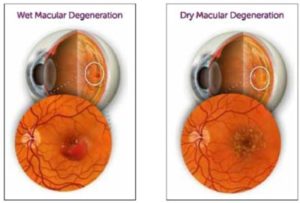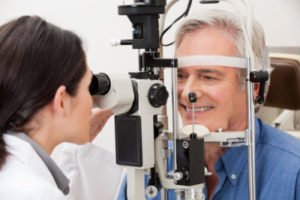Santa Ana Macular Degeneration Specialist
 If a Santa Ana AMD specialist recently diagnosed you with macular degeneration, you may be at a loss for words. You may have never dreamed that you would be diagnosed with this eye condition. However, it is important to learn as much as you can about this condition because there is a lot of misinformation. Here are some common myths about macular degeneration.
If a Santa Ana AMD specialist recently diagnosed you with macular degeneration, you may be at a loss for words. You may have never dreamed that you would be diagnosed with this eye condition. However, it is important to learn as much as you can about this condition because there is a lot of misinformation. Here are some common myths about macular degeneration.
- If you get diagnosed with macular degeneration, you can’t do anything. Some people assume that once they develop this eye condition, that’s it. Although there’s no cure, treatments are available to slow down progression. Common treatments include laser therapy, vitamins, and anti-angiogenic drugs. Your eye doctor can help you choose the proper treatment.
- Not many people develop macular degeneration. This is one of the most common misconceptions about macular degeneration. The truth is, however, that it’s one of the most common eye diseases among older people. Although rare, the disease can also occur in younger people.
- Macular degeneration shows obvious symptoms in the beginning. Unfortunately, macular degeneration seldom presents symptoms in the early stages. Most people don’t even notice they have the condition until they have lost some vision. That’s why regular eye exams are essential. Your eye doctor will check for early signs of macular degeneration and treat it accordingly. The earlier you treat this eye disease, the better. Try to schedule eye exams once a year. If you have a family history of macular degeneration, you may need to schedule more frequent checkups.
- It’s impossible to prevent macular degeneration. The direct cause of macular degeneration is unknown, but that doesn’t mean you can’t take steps to reduce your risk of developing the disease. For example, your Santa Ana AMD specialist may recommend eating leafy green vegetables, fatty fish, eggs and nuts. You should also avoid smoking, maintain a healthy weight and protect your eyes from the sun.
- If you have macular degeneration, you will be completely blind. This is not true. Macular degeneration affects the central part of your retina, so you may have difficulty reading and recognizing faces. However, your peripheral vision will remain intact.
If you have additional questions about macular degeneration, you should schedule an appointment with a Santa Ana AMD specialist. At Retina Associates of Orange County, we understand how overwhelmed and scared you might feel and are here to help you every step of the way.

When it comes to body parts the eyes are a very crucial component that makes everyday activities all the easier. In addition to being very important, eyes are also extremely complex despite their relatively small size. Unfortunately, with this complexity comes the possibility for problems and diseases to arise that are often more common as a patient becomes older.
Of these complications, Age-related Macular Degeneration (AMD) in particular can be especially difficult to deal with. If you or a loved one are suffering from AMD or believe you may have possible symptoms then you’ll want to contact a Santa Ana AMD Specialist by calling Retina Associates of Orange County.
What is Age-related Macular Degeneration (AMD)?
As the name suggests Age-related Macular Degeneration (AMD) is a disease that mostly affects older patients (50 and over) and is named after the macula, which is the part of the retina that handles central vision. Since peripheral vision is generally not affected by macular degeneration the loss/reduction of the patient’s vision may only become noticeable when engaging in activities such as reading or driving.
Since AMD is painless and only affects the patient’s central vision it can often go unnoticed for quite some time but will get worse as time progresses especially for patients over 65 and who deal with health problems such as high cholesterol or habits like smoking. Any change in your vision should prompt you to immediately enlist the services of a Santa Ana AMD Specialist. Some common symptoms of AMD include:
- Distorted, blurry, or unclear vision.
- A black spot floating in your central vision.
- Difficulty engaging in tasks such as reading or driving.
How a Specialist Can Test/Treat You for AMD
There are a few ways a specialist can test you to first determine if you have AMD. To begin with, AMD often occurs in one eye before the other. As such patients may only notice their symptoms when covering one eye and this method is a good indicator that you may have AMD. Of course, you’ll still want your physician to test you at which point they might use an Amsler grid macular degeneration test. After identifying if you have AMD there are a few treatments available.
Unfortunately, it can be difficult to completely reverse the effects of AMD especially as the disease is closely related to aging. However, there are still a few treatment options available:
- Anti-oxidants and carotenoids (Vitamins C, Vitamin E, Zeaxanthin, Lutein, and minerals like copper and zinc) have demonstrated that they can slow the disease when it has entered the intermediate phase.
- For wet macular degeneration, laser photocoagulation or photodynamic therapy (PDT) are possibilities.
- When leakage is within the central vision a new class of drugs (anti-VEGF) can be injected into the eye. These drugs include Alfibercept (Eylea®), Ranibizumab (Lucentis®), and Bevacizumab (Avastin®).
Contact a Specialist Today
Dealing with AMD can be a stressful event and even if you’re not sure you have AMD, any noticeable loss or reduction in your vision should prompt you to see your physician immediately. Whether you’ve been diagnosed with AMD or believe you may have, you should contact a Santa Ana AMD Specialist by calling us at Retina Associates of Orange County.
